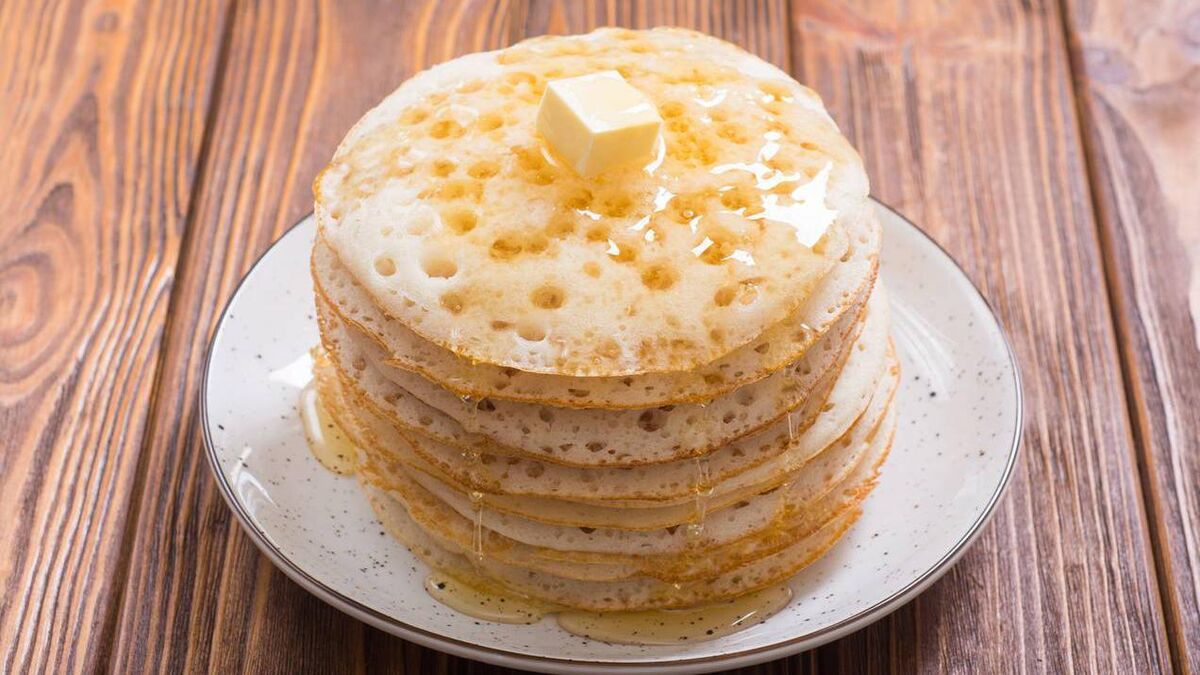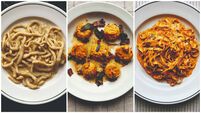Darina Allen: Nothing beats the smell of freshly-baked bread — try these recipes

Soda bread is the bread of our country and is literally made in minutes.
The tantalising smell of freshly baked bread is one of the most nostalgic and irresistible aromas for all of us, and even though I’ve been baking bread all of my adult life and most of my childhood, I still get a buzz every time I take a crusty loaf out of the oven.
So do all the 12-Week students at Ballymaloe Cookery School. They learn how to make ten to fifteen different breads while they are with us.
Soda breads take minutes to make. For flatbreads, all you need is a heavy frying pan or griddle. You don’t even need an oven, so they are also perfect for students who may have limited facilities in their accommodation.
Sourdough can be fitted into your particular routine. Here at the cookery school, we make a 48-hour fermented loaf that spends most of its time in the fridge, and is baked first thing in the morning, which works brilliantly for us.
The starter can be frozen or dehydrated which is really helpful, if your lifestyle dictates that you can only be a random baker.
Here at the Cookery School, anything from ten to twenty students from the group turn up to the Bread Shed at 6am for what is an extracurricular activity — how about that enthusiasm?
Many become total sourdough nerds, monitoring and comparing their loaves every day, endlessly in search of the perfect sourdough loaf.
Good bread is super-important for all of our families’ health.
I’m on record as saying on live TV that if I was Minister for Health, the first thing I would do for the health of the nation is to ban the ultra-processed sliced pan, and I haven’t changed my mind since.
Is it a coincidence that the number of gluten allergies and intolerances are growing exponentially? Check the label…
Here at the cookery school, where many students arrive convinced that they need to be gluten-free, discover that they can happily eat our natural, fermented sourdough made with organic flour.
When they eat ‘sliced pan’ from the shops, all the symptoms return.
For bread-baking at home, do go out of your way to find organic, chemical-free flour.
Soda bread is the bread of our country and is literally made in minutes.
Scones will be out of the oven in little more than 10 minutes, a crusty loaf takes 30 to 35 minutes, and a ‘tin loaf’ will take all of an hour - it takes time, but not your time.
The actual mixing takes mere minutes, so much joy for so little effort and nothing’s changed, the way to everyone’s heart is through their tummy… Don’t we all love Mum’s soda bread?
November 17 is National Homemade Bread Day, so let’s celebrate passing on the skills to all the family by making some crusty loaves of bread.
Baking is an exact science, so make sure to weigh your ingredients accurately, otherwise you’ll have a very inconsistent and disappointing result.
Here are a few recipes to get you started.
I’ve included the recipe for traditional white soda bread in response to many requests received, but there are many, many more easy and well-tested recipes, including a brilliant gluten-free chapter by Debbie Shaw, in , published by Gill Books in 2023.
Ballymaloe Sourdough Bread
Every loaf is an adventure. Each will be slightly different and every time you make a loaf you will learn more about the process. Enjoy experimenting and remember, people have been making sourdough bread for centuries.

Course
BakingIngredients
340g sourdough starter (see The New Ballymaloe Bread Book by Darina Allen, published by Gill Books)
200g cold water
230g strong white flour
70g malted/granary flour
20g rye flour
5g wheat germ
11g salt
Method
Prepare your sourdough starter, as per The New Ballymaloe Bread Book by Darina Allen, published by Gill Books.
Put the starter, water, flours and wheat germ in the bowl of a stand mixer. Mix with a dough hook on a slow speed for a few seconds, until the dough has combined. Rest the dough for 5 minutes.
After resting, add the salt and turn the mixer on a slow speed – if you beat it too fast at this stage, you can break the gluten. When the dough is sticking to the sides of the bowl and coming away in strings, this is the gluten being developed. Increase the speed and continue to mix until it doesn’t stick to the sides of the bowl and the dough hook lifts the dough cleanly out.
Place the dough in a bowl, cover and leave to rest in the fridge for 24 hours.
The next day, for the first shaping, pour the dough out of the bowl onto a clean work surface and knock it back. Stretch and fold the dough a few times, then shape it into a smooth, tight, round ball and leave to rest for 15-20 minutes in a cool kitchen or 5–10 minutes in a warm kitchen.
Stretch and fold the dough a few times. Turn and push to shape it into a smooth, tight round ball.
For the second shaping, flip your dough over, flatten and spread it out with your fingers. Pull all the edges into the centre of the dough – this helps to trap the CO2 and gases in the dough to give it a nice airy crumb. Flip it back over with a dough scraper (or roll it over) and shape into a smooth, tight, round ball again. The tighter and less sticky the ball is, the better it will hold its shape and rise in the oven. If it’s too tight, though, the surface will rip and become sticky again. If this happens, rest the dough again for 10-15 minutes and repeat.
Flip the dough over. Pull all the edges into the centre of the dough. Flatten and spread it out with your fingers. Put the dough upside down into a lined, floured banneton (or in a 16-20cm bowl lined with a clean linen tea towel and floured) and leave in the fridge, covered, overnight or for up to 24 hours.
The next day, put a casserole/Dutch oven with its lid on in the oven to preheat. (For this recipe, the lid must be flat. Alternatively, you could cook the loaf directly on a hot baking tray in the oven, but this is the least good option for home baking.) Preheat the oven fully to its maximum temperature or at least 250°C/Gas Mark 9. It is essential that the casserole/Dutch oven is fully preheated, overwise the bread will stick firmly to the base. It will take 30-35 minutes for the heat to penetrate completely.
Meanwhile, take the dough out of the fridge and allow it to sit at room temperature while the casserole/Dutch oven is preheating.
Using an oven mitt or thick tea towel, lift the hot casserole/Dutch oven out onto a pot rack. Lift off the lid and carefully turn the dough out of the banneton onto the upturned lid. Slash the top with a sharp serrated knife or baker’s blade (lame) and mist lightly with water (optional).
Replace the casserole/Dutch oven base on top of the lid and quickly put it back in the hot oven. Reduce the temperature to 230°C/Gas Mark 8 and bake for 20 minutes. Remove the upturned base and continue to bake the bread on the lid for 10-15 minutes, until the crust is dark golden brown. When fully cooked, the bread will feel light and will sound hollow when tapped on the base. Cool on a wire rack.
Traditional Irish White Soda Bread
Soda bread only takes 2 or 3 minutes to make and 30 - 40 minutes to bake, scones will be ready in just 10 minutes. It is certainly another of my 'great convertibles'. We have had the greatest fun experimenting with different additions and uses.

Servings
1Preparation Time
20 minsCooking Time
45 minsTotal Time
1 hours 5 minsCourse
BakingIngredients
450g plain white flour
1 level tsp salt
1 level tsp bread soda sour milk or buttermilk to mix – 350-400ml approx.
Method
First fully preheat your oven to 230ºC/Gas Mark 8.
Sieve the dry ingredients into a large bowl. Make a well in the centre. Pour most of the milk in at once. Using just one hand to mix with your fingers stiff and outstretched, like a claw, mix in a full, circular movement from the centre to the outside of the bowl, adding more milk if necessary. The dough should be softish, not too wet and sticky.
When it all comes together, turn it out onto a well-floured work surface. WASH AND DRY YOUR HANDS.
Then with floured hands, tidy it up and flip over gently. Pat the dough into a round, about 4cm deep and cut a cross on it (the traditional blessing), then prick in the four corners to let the fairies out of the bread, otherwise they will jinx it!
Transfer to a baking tray.
Bake in a hot oven, 230ºC/Gas Mark 8 for 15 minutes, then reduce the heat to 200ºC/Gas Mark 6 for 30 minutes or until cooked. If you are in doubt, tap the bottom of the bread, when it is cooked it will sound hollow.
Cool on a wire rack.
Baghrir from L’Hôtel Marrakech in Marrakech
These Moroccan ‘crepes’ are also called thousand-hole pancakes because of their honeycomb appearance. This recipe comes from L’Hôtel Marrakech in Morocco, one of my favourite places to stay in the whole world.

Servings
6Preparation Time
15 minsCooking Time
5 minsTotal Time
20 minsCourse
BakingIngredients
200g fine semolina
400ml tepid water
1 – 1 ½ tbsp (orange blossom water
1 tsp vanilla extract
½ tsp baking powder
½ tsp caster sugar
pinch salt
½ tsp dried yeast
2 x 7g sachets of instant yeast
Method
Put all the ingredients except the yeast in a blender and whizz for 5 minutes, until bubbles appear.
Add the dried yeast and blend for a further 2 minutes. Allow the mixture to stand for about 5 minutes, until the mixture looks foamy, before starting to cook.
Heat a 12cm pan over medium heat. Fill a 75ml ladle with batter, pour it into the pan and gently tilt to cover the base. Cook for 3-4 minutes, until all the bubbles burst, and the surface looks dry.
Serve three or four baghrir on a warm plate with a mixture of equal quantities of melted butter and honey.
Excitement is building, don’t miss the Ballymaloe Craft Fair which runs over two weekends (November 15-17 and 22–24) with over 200 Irish craft and design exhibitors each weekend, including food and entertainment.

by ornithologist Seán Ronayne.
A beautiful, evocative book, superbly written in haunting prose.
Seán always knew he was different. Nicknamed ‘nature boy’ by the other kids as a child, he struggled to fit in and regularly escaped to the wood and coastlines around his home in Cork.
The natural world was his happy place and where he discovered his true passion – identifying and understanding birds through their sound and song.
At the age of 32, Sean received an autism diagnosis, and his life finally started to make sense.
In this book, Sean takes us on his journey.
From his adventures in the Sahara Desert, the jungles of Nepal and the streets of Thailand, to discovering the night sounds of Catalunya, and his mission to sound-record all the regularly occurring bird species in Ireland, Nature Boy is an inspiring story of love, connection and the healing power of nature. Published by Hachette Ireland.





